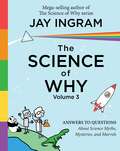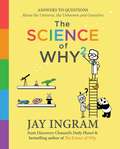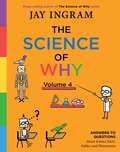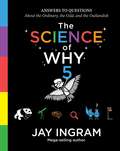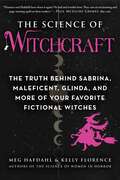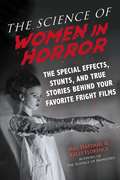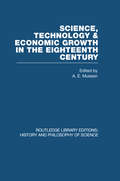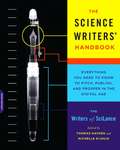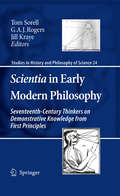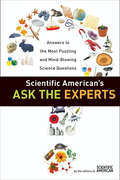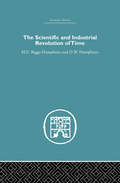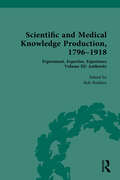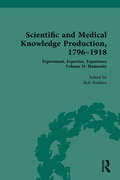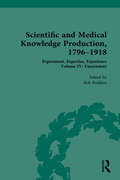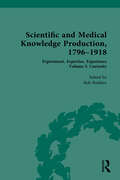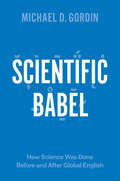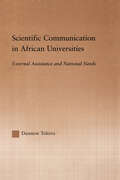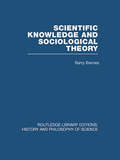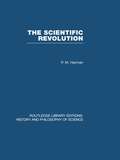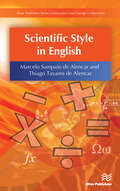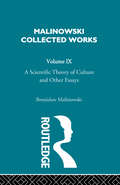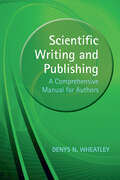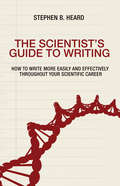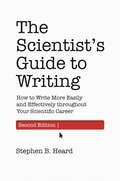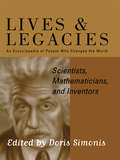- Table View
- List View
The Science of Why: Answers to Questions About Science Myths, Mysteries, and Marvels
by Jay IngramThe newest volume in the beloved Science of Why series—full of fascinating science that will amuse and astonish readers of all ages.Have you wondered why you cringe when fingernails are scratched along a chalkboard? Or whether you could ever have a cybernetic limb? Or if a shark can smell a drop of blood a mile away? Then you’re in luck! Bestselling author Jay Ingram is back to answer all those questions and more as he explores and explains the world around us in all of its head-scratching curiosity. From the smallest parts inside us to the biggest questions about our universe, Jay tackles pressing topics, such as: Could we use a laser to shoot an asteroid that was about to hit earth? What exactly was a dodo and why did it go extinct? Why do beans make me fart? Touching on everything from food to robots to space to the animal kingdom, The Science of Why 3 is perfect for anyone who has stayed up late into the night pondering the weird and wonderful world we live in. Full of captivating science questions (and answers!), this book is sure to surprise and delight science readers of all ages.
The Science of Why 2: Answers to Questions About the Universe, the Unknown, and Ourselves
by Jay IngramAn all-new volume of science questions to delight, entertain, and inform readers of all ages, from bestselling author Jay Ingram.Bestselling author and commentator Jay Ingram is back to explain the magic and mysteries of the world around us. Jay takes readers on a tour of the universe, exploring wonders big and small. From the farthest reaches of space to the most perplexing historical riddles to the marvels of who we are and what we’re made of, Jay answers the important questions, such as: What’s inside a black hole? Will machines ever learn to feel? How much pee is in the average swimming pool? Because who hasn’t wondered whether we’re living in a computer simulation? Or whether Atlantis existed? Or why cats always land on their feet? With wit, wisdom, and whimsical illustrations, The Science of Why 2 will delight readers of all ages with the answers to all these questions and more. Full of fun science facts (and fictions), this is the book that everyone’s inner science geek needs to read.
The Science of Why, Volume 4: Answers to Questions About Science Facts, Fables, and Phenomena (The Science of Why series #4)
by Jay IngramBack by popular demand: a brand-new volume of science queries, quirks, and quandaries in the mega-bestselling Science of Why series, sure to enlighten and entertain readers of all ages.Have you ever wondered why we close our eyes when we sneeze? Or how far underground things can live? Or if there&’s a way to choose the fastest lineup at the grocery store? Yes? Then fasten your seat belts! Bestselling author Jay Ingram is here to take you on a rollercoaster ride through science&’s most perplexing puzzles. From the age-old mysteries that have fascinated us to the pressing unknowns about our future and all the everyday wonderings in-between, Jay answers questions that confound and dumbfound, such as: Why do zebras have stripes? How many universes might there be? Can we live for 200 years? ...along with everything you ever wanted to know about alien civilizations, photographic memories, nanobots, poop, and (conveniently) toilet paper. Bursting with laugh-out-loud illustrations, jaw-dropping marvels, and head-scratching science fictions, The Science of Why, Volume 4 will give readers of all stripes a real thrill.
The Science of Why, Volume 5: Answers to Questions About the Ordinary, the Odd, and the Outlandish (The Science of Why series #5)
by Jay IngramChock-full of peculiar puzzles, mind-bending mythbusters, and quirky questions, the fifth pop science book in the bestselling Science of Why series is perfect for anyone curious about the weird and wondrous world we live in.Have you ever wondered if octopuses are from outer space? What Mexican jumping beans are? Or if banana peels are really slippery? If questions like these are keeping you up at night, you can rest easy. Bestselling author Jay Ingram is here to answer all the whimsical and whacky wonderings that have baffled people since the dawn of time. From our bodies to our pets (and other beasts) to the natural world around us, Jay tackles science topics big and small, such as: Did dinosaurs sit on their eggs? What is our funny bone? Is there a specific muscle that makes dogs cute? Because who hasn&’t pondered whether plants have feelings? Or if Robin Hood was a real person? Or what humans will look like in the future? Teeming with amusing answers to bemusing questions—and handy and hilarious illustrations—this latest volume separates fact from fiction, lesson from legend, and myth from marvel. Endlessly illuminating and entertaining, The Science of Why, Volume 5 is five times the fun for new and old readers of the series.
The Science of Witchcraft: The Truth Behind Sabrina, Maleficent, Glinda, and More of Your Favorite Fictional Witches (The Science of)
by Meg Hafdahl Kelly FlorenceA scientific discovery of witches in fiction—Chilled Adventures of Sabrina, Sleeping Beauty, Wicked and so many more! Kelly Florence and Meg Hafdahl, authors of The Science of Women in Horror and co-hosts of the Horror Rewind podcast called &“the best horror film podcast out there&” by Film Daddy, present a guide to the history of witchcraft through the stories and characters we all know and love. Reveal the spellbinding science behind the legends and lore surrounding fiction&’s most iconic witches, answering such questions as: What is the science behind divination and spellcraft?When did witchcraft begin to show up in literature and media?Has science made it possible to uncover the truth behind the powers of necromancy and employing familiars?How has witchcraft been thought of throughout the world? Through interviews, film and literary analysis, and bone-chilling discoveries, join Kelly and Meg as they learn about the complicated and rich science of witchcraft throughout the centuries and discover why now is the season of the witch!
The Science of Women in Horror: The Special Effects, Stunts, and True Stories Behind Your Favorite Fright Films
by Meg Hafdahl Kelly FlorenceFrom scream queens to femmes fatale, horror isn&’t just for the boys. Gothic media moguls Meg Hafdahl and Kelly Florence, authors of The Science of Monsters, and co-hosts of the Horror Rewind podcast called &“the best horror film podcast out there&” by Film Daddy, present a guide to the feminist horror movies, TV shows, and characters we all know and love. Through interviews, film analysis, and bone-chilling discoveries, The Science of Women in Horror uncovers the theories behind women&’s most iconic roles of the genre. Explore age-old tropes such as &“The Innocent&” like Lydia in Beetlejuice, &“The Gorgon&” like Pamela Voorhees in Friday the 13th, and &“The Mother&” like Norma Bates in Pyscho and Bates Motel, and delve deeper into female-forward film and TV including: The Haunting of Hill HouseTeethChilling Adventures of SabrinaBuffy the Vampire SlayerAnd so much more! Join Kelly and Meg in The Science of Women in Horror as they flip the script and prove that every girl is a &“final girl.&”
Science, technology and economic growth in the eighteenth century
by A E MussonOriginally published in 1972.This book illustrates the growing awareness of the importance of science and technology in the Industrial Revolution. The contributors show that the growth in the teaching and literature of natural philosophy (mechanics, hydraulics etc), mathematics and chemistry, together with such new agencies as "philosophical societies", itinerant lecturers and libraries were significant factors in the development of the Industrial Revolution.
The Science Writers' Handbook: Everything You Need to Know to Pitch, Publish, and Prosper in the Digital Age
by Thomas Hayden Michelle NijhuisPopular science writing has exploded in the past decade, both in print and online. Who better to guide writers striving to succeed in the profession than a group of award-winning independent journalists with a combined total of 225 years of experience? <P><P>From Thomas Hayden’s chapter on the perfect pitch to Emma Maris’s advice on book proposals to Mark Schrope’s essential information on contracts, the members of SciLance give writers of all experience levels the practical information they need to succeed, as either a staffer or a freelancer. Going beyond craft, The Science Writer’s Handbook also tackles issues such as creating productive office space, balancing work and family, and finding lasting career satisfaction. It is the ultimate guide for anyone looking to prosper as a science writer in the new era of publishing.
Scientia in Early Modern Philosophy
by Jill Kraye Tom Sorell G. A. RogersScientia is the term that early modern philosophers applied to a certain kind of demonstrative knowledge, the kind whose starting points were appropriate first principles. In pre-modern philosophy, too, scientia was the name for demonstrative knowledge from first principles. But pre-modern and early modern conceptions differ systematically from one another. This book offers a variety of glimpses of this difference by exploring the works of individual philosophers as well as philosophical movements and groupings of the period. Some of the figures are transitional, falling neatly on neither side of the allegiances usually marked by the scholastic/modern distinction. Among the philosophers whose views on scientia are surveyed are Hobbes, Descartes, Spinoza, Gassendi, Locke, and Jungius. The contributors are among the best-known and most influential historians of early modern philosophy.
Scientific American's Ask the Experts: Answers to The Most Puzzling and Mind-Blowing Science Questions
by Editors of Scientific AmericanWhy is the night sky dark? How do dolphins sleep without drowning? Why do hangovers occur? Will time travel ever be a reality? What makes a knuckleball appear to flutter? Why are craters always round?There's only one source to turn to for the answers to the most puzzling and thought-provoking questions about the world of science: Scientific American. Writing in a fun and accessible style, an esteemed team of scientists and educators will lead you on a wild ride from the far reaches of the universe to the natural world right in your own backyard. Along the way, you'll discover solutions to some of life's quirkiest conundrums, such as why cats purr, how frogs survive winter without freezing, why snowflakes are symmetrical, and much more. Even if you haven't picked up a science book since your school days, these tantalizing Q & A's will shed new light on the world around you, inside you, below you, above you, and beyond!
The Scientific and Industrial Revolution of Time (Economic History Ser.)
by M.E. Beggs Humpreys D.W. HumphreysFirst Published in 2005. Routledge is an imprint of Taylor & Francis, an informa company.
Scientific and Medical Knowledge Production, 1796-1918: Volume III: Authority
by Rob BoddiceIncreasingly, critics accused practitioners of hiding hubris behind their purported humanity and questioned whether an increasingly professional scientific community could retain its grip on the meaning of compassion. This volume presents a set of responses to this criticism and others, showing the extent to which the lived-experience of scientific practice became a justification in and of itself for the expression of social, political and cultural authority. Bare knowledge, as it was presented, came with an enormous social valuation. These sources show how that authority changed and grew over time.
Scientific and Medical Knowledge Production, 1796-1918: Volume II: Humanity
by Rob BoddiceThis volume foregrounds humanity (in the sense of compassion or sympathy), which often supplied the motivation for medical experiment and scientific innovation. Though the results of experiments could not be known in advance, often the stated goal was the reduction of suffering, the cure of disease, or the easement of life. Increasingly, critics accused practitioners of hiding hubris behind their purported humanity and questioned whether an increasingly professional scientific community could retain its grip on the meaning of compassion.
Scientific and Medical Knowledge Production, 1796-1918: Volume IV: Uncertainty
by Rob BoddiceThis volume showcases doubt from within the scientific community itself. These sources dwell upon the moments at which ideas became challenged, when facts were revealed to be fiction, and when knowns reverted to unknowns. But the focus is not the ideas and facts themselves, but on the ways in which scientists adjusted themselves to new landscapes of uncertainty in their particular cultural and professional practices.
Scientific and Medical Knowledge Production, 1796-1918: Volume I: Curiosity
by Rob BoddiceThis volume is divided according to moral themes within medicine and science. The sources represent dominant notes within the culture of knowledge production that capture the moral/emotional/social justification for the making of expertise through experiment. This volume focuses on curiosity, given as the scientist’s chief motivating factor for the finding of new facts, and as an essential character trait for anyone entering the scientific life. It is also the source of controversy and criticism, since curiosity alone increasingly looked amoral at best and immoral at worst, as the nineteenth century wore on.
Scientific Babel: How Science Was Done Before and After Global English
by Michael D. GordinEnglish is the language of science today. No matter which languages you know, if you want your work seen, studied, and cited, you need to publish in English. But that hasn’t always been the case. Though there was a time when Latin dominated the field, for centuries science has been a polyglot enterprise, conducted in a number of languages whose importance waxed and waned over time—until the rise of English in the twentieth century. So how did we get from there to here? How did French, German, Latin, Russian, and even Esperanto give way to English? And what can we reconstruct of the experience of doing science in the polyglot past? With Scientific Babel, Michael D. Gordin resurrects that lost world, in part through an ingenious mechanism: the pages of his highly readable narrative account teem with footnotes—not offering background information, but presenting quoted material in its original language. The result is stunning: as we read about the rise and fall of languages, driven by politics, war, economics, and institutions, we actually see it happen in the ever-changing web of multilingual examples. The history of science, and of English as its dominant language, comes to life, and brings with it a new understanding not only of the frictions generated by a scientific community that spoke in many often mutually unintelligible voices, but also of the possibilities of the polyglot, and the losses that the dominance of English entails. Few historians of science write as well as Gordin, and Scientific Babel reveals his incredible command of the literature, language, and intellectual essence of science past and present. No reader who takes this linguistic journey with him will be disappointed.
Scientific Communication in African Universities: External Assistance and National Needs (RoutledgeFalmer Studies in Higher Education)
by Damtew TeferraFirst Published in 2003. Routledge is an imprint of Taylor & Francis, an informa company.
Scientific Knowledge and Sociological Theory (Routledge Library Editions: History & Philosophy of Science)
by Barry BarnesOriginally published in 1974. Scientific Knowledge and Sociological Theory centres on the problem of explaining the manifest variety and contrast in the beliefs about nature held in different groups and societies. It maintains that the sociologist should treat all beliefs symmetrically and must investigate and account for allegedly "correct" or "scientific" beliefs just as he would "incorrect" or "unscientific" ones. From this basic position a study of scientific beliefs is constructed. The sociological interest of such beliefs is illustrated and a sociological perspective upon scientific change is developed.
The Scientific Revolution (Routledge Library Editions: History & Philosophy of Science)
by Peter HarmanOriginally published in 1983.This volume outlines some of the important innovations in astronomy, natural philosophy and medicine which took place in the sixteenth and seventeenth centuries, and shows how the transformation in world-view during the period was affected by broader historical terms. Themes such as the spread of Puritanism, the decline of witchcraft and magic, and the incorporation of science as an integral part of the intellectual milieu of late seventeenth-century England.
Scientific Style in English (River Publishers Series In Innovation And Change In Education Ser.)
by Marcelo Sampaio Alencar Thiago Tavares AlencarStyle is a distinctive manner of expression, in writing or speech. The wordevolved from Latin stilus, an instrument for writing, marking, or incising,such as something used by the ancients in writing on clay or waxed tablets.It is the way in which something is said or done, as distinguished fromits substance. Style is also a convention with respect to spelling, punctuation,capitalization, and typographic arrangement and display followed in writingor printing.Scientific Style in English aims to help students with the reading and writing of scientific and technical texts in English, with a particular focus on style, grammar and math. It can be used by students and professionals with basic or intermediate understanding of theEnglish language.Technical topics discussed in the book include: Scientific Style in English Mathematical Style in English Technical Style Stylistic Problems in English How to write Theses and Dissertations
A Scientific Theory of Culture and Other Essays: [1944]
by Bronislaw MalinowskiPublished, posthumously, this volume is both a summing up and a reformulation of Malinowski's functional theory of culture.
Scientific Writing and Publishing: A Comprehensive Manual for Authors
by Denys WheatleyKnowing how to prepare, write and publish high-quality research papers can be challenging for scientists at all stages of their career. This manual guides readers through successfully framing and presenting research findings, as well as the processes involved in publishing in learned journals. It draws on the author's wealth of practical experience, from working in academic research for over 40 years and teaching scientific writing in over 20 countries, to gaining insights as a journal editor. Well-written and logical, it provides clear step-by-step instructions to enable readers to become more effective at writing articles, and navigating difficulties related to journal submission, the review process, editing and publication. It comprehensively covers themes such as publication ethics, along with current topics including Open Access publishing and pre-print servers. This is a useful, user-friendly guide for graduate students, early career scientists, and more experienced researchers, particularly in the life and medical sciences.
The Scientist's Guide to Writing: How to Write More Easily and Effectively throughout Your Scientific Career
by Stephen B. HeardThe ability to write clearly is critical to any scientific career. The Scientist's Guide to Writing provides practical advice to help scientists become more effective writers so that their ideas have the greatest possible impact.Drawing on his own experience as a scientist, graduate adviser, and editor, Stephen Heard emphasizes that the goal of all scientific writing should be absolute clarity; that good writing takes deliberate practice; and that what many scientists need are not long lists of prescriptive rules but rather direct engagement with their behaviors and attitudes when they write. He combines advice on such topics as how to generate and maintain writing momentum with practical tips on structuring a scientific paper, revising a first draft, handling citations, responding to peer reviews, managing coauthorships, and more.In an accessible, informal tone, The Scientist's Guide to Writing explains essential techniques that students, postdoctoral researchers, and early-career scientists need to write more clearly, efficiently, and easily.Emphasizes writing as a process, not just a productEncourages habits that improve motivation and productivityExplains the structure of the scientific paper and the function of each partProvides detailed guidance on submission, review, revision, and publicationAddresses issues related to coauthorship, English as a second language, and more
The Scientist’s Guide to Writing, 2nd Edition: How to Write More Easily and Effectively throughout Your Scientific Career
by Stephen B. HeardAn updated and expanded edition of the acclaimed writing guide for scientistsThe Scientist’s Guide to Writing explains the essential techniques that students, postdocs, and early-career scientists need to write more clearly, efficiently, and easily. Now fully updated and expanded, this incisive primer offers practical advice on such topics as generating and maintaining writing momentum, structuring a scientific paper, revising a first draft, handling citations, responding to peer reviews, managing coauthorships, and more. The ability to write clearly is critical to any scientific career. The Scientist’s Guide to Writing shows scientists how to become better writers so that their ideas have the greatest possible impact.New chapters discuss effective reading, choosing the right journal for your research, and the advantages and disadvantages of posting preprintsProvides additional advice on reporting statistical results, dealing with conflicting peer reviews, managing coauthorships, writing with English as an additional language, and moreEmphasizes writing as a process, not just a productEncourages habits that improve motivation and productivityOffers detailed guidance on submission, review, revision, and publicationIncludes a wealth of new exercises
Scientists, Mathematicians and Inventors: An Encyclopedia Of People Who Changed The World (Lives And Legacies Ser.)
by Kelly Wilson Caroline Hertzenberg John Luoma Tami Schuyler Jonathan Secaur Doris Simonis Daniel Steinberg Valerie Tomaselli Gayle WeaverScientists, Mathematicians, and Inventors provides biographies of 200 men and women who changed the world by leaving lasting legacies in the fields of science, mathematics, and scientific invention. It fills a gap in the biographical reference shelf by offering far more than basic facts about a scientist's life and work: each entry describes not only the immediate effects of the individual's discoveries, but also his or her impact on later scientific findings.
